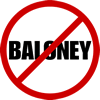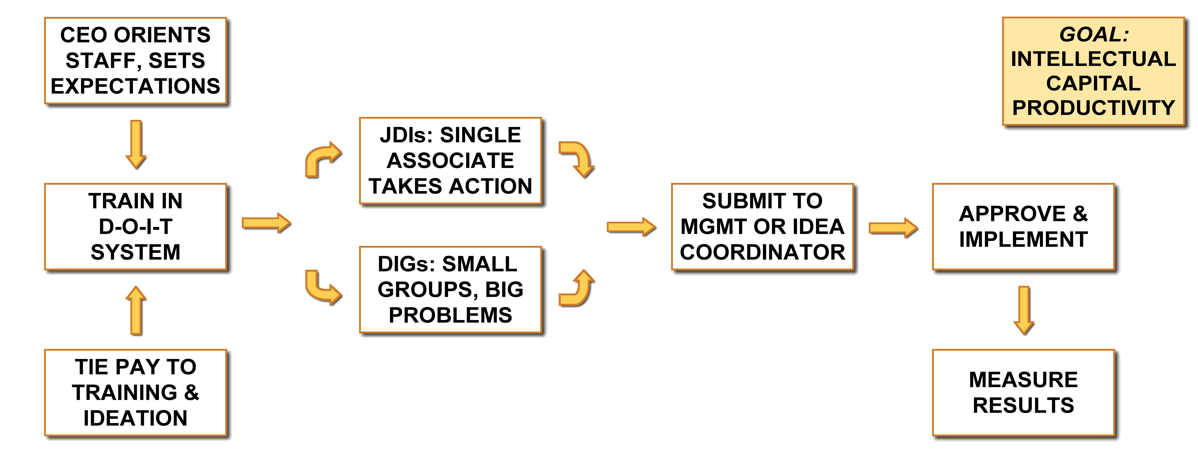Ideation Mining
Releasing Intellectual Capital
GSM requires an organized system to collect employee ideas. This is not about a simple and ineffective suggestion program, but a house-wide approach that requires the wide-scale implementation of Associate intellectual capital. This approach consistently yields millions of dollars in its first year of implementation because intellectual capital is the antecedent of financial capital. Why settle for a hundred projects done when you can have thousands? Ideation Mining System.zip
The Baloney of “Low-Hanging Fruit”
A criticism of this simple ideation approach from the old TQM movement was that employee ideas  were “low-hanging fruit”, a language that was a put-down of bubble-up ideation in favor of more sophisticated and limited involvement of mainline quality management processes. But any farmer knows that most of the fruit on a tree is low hanging, and that apples don’t taste any better based on where they hang. The wise farmer never makes the mistake of harvesting only high-hanging apples!
were “low-hanging fruit”, a language that was a put-down of bubble-up ideation in favor of more sophisticated and limited involvement of mainline quality management processes. But any farmer knows that most of the fruit on a tree is low hanging, and that apples don’t taste any better based on where they hang. The wise farmer never makes the mistake of harvesting only high-hanging apples!
Experience teaches that the JDI/DIG approach is an ideal way to begin unleashing and managing intellectual capital. People get over their initial hesitancies, experience success, and gain confidence. By the end of the first year, high power quality management tools and approaches can be introduced as a supplement to overall ideation management, and used on processes sufficiently complicated to warrant them. The fact is that some of the organization’s defects are major, some are minor, and under GSM, all are intolerable. The argument that quality is more important than quantity is a fallacy. In management we want both quality and quantity of change.
![]() PeopleCapital/IdeationMining — The process by which ideas are gathered, developed, and implemented (referred to as Do It Groups - DIGs, and Just Do Its - JDIs): Ideation Mining System.zip
PeopleCapital/IdeationMining — The process by which ideas are gathered, developed, and implemented (referred to as Do It Groups - DIGs, and Just Do Its - JDIs): Ideation Mining System.zip

Build a System to Capture & Implement Intellectual Capital
- The CEO sets the tone by establishing that the hospital is a learning organization, that it is an applied science business, and that its people's intellectual capability is its primary resource. People, all of them, are valuable for their capability to solve problems, and that this capability is not limited to those who were formally schooled. "I need your help" - the 4 most powerful words. Typical expectations include:
- A required number of implemented ideas per Associate per year. Three implemented ideas per person has been obtained routinely by many healthcare organizations. Measure ideation by employee and department to spot productivity problems.
- Managers are expected to implement 95% of ideas submitted, at least in part. This gives managers the ability to turn down a few ideas, and requires them to work with the team to find ways to make their ideas work.
- This is a no-fail system—there are no bad ideas. Associates are thanked for submitting an idea. If an idea cannot be accepted in full or is only partially implemented, the Associate is thanked for their contribution and encouraged to submit their next idea. This is accompanied by a host of recognitions and rewards for ideas.
- Rules are laid out: Solutions must be no cost or low cost, fit the hospital’s declared values and business objectives, and must be practical. Such ideas are nearly all approved. Pay and benefits questions are off limits and reserved to executive discretion.
- New skills require new training. One hour of training in a four-step problem-solving process called DO-IT is required of all staff, thus providing all with the same tools and process for problem solving. DO-IT: Define the problem; Outline options for solution; Implementation plan; Track results.
- Where an idea can be developed and implemented by a single person it is labeled a JDI (Just Do It) and is carried out by the submitter, with management assistance as needed. Where more than one person or department is needed to address an issue it becomes a DIG (Do It Group) and the originator of the idea can be a member of the DIG if they wish.
- An ROI worksheet is submitted with each recommended solution or idea for improvement. Ideas that represent substantial investment have a good chance for approval if the ROI (return on investment) picture is positive in the first 12 months. Many ideas are impossible to measure in terms of ROI and are installed simply for their obvious business value.
- All stakeholders are involved in the solution or change are engaged in the process. The team’s manager approves problem solutions within the department. An idea submitted for other departments or that is interdepartmental go to a small task force we have called the Management Action Council where they are logged and administered.
- The system requires participation in the education and ideation steps as a prerequisite to any future promotions or pay increases. Coming up with ways to improve things is not a tack-on task but becomes a core part of everyone’s job, and written into every job description—people are paid to think and change the system, not simply to run yesterday’s ineffective solutions.
Idea Payoff
The experience of organizations implementing a JDI/DIG process shows that the average idea has a tangible ROI of $2500-$4000 in the first year. The average ROI is derived by dividing the tangible ROI realized by the total number of implemented JDIs/DIGs, including those that have tangible ROI and those without. ROI is proposed at the time of implementation of the probosal and is evaluated and approved by someone in your financial management department.
-
Exercise: To get an estimate of value of unmined intellectual capital in your organization, multiply the organization’s headcount by three to get the number of ideas that can be implemented in the first year—your ideation budget. Then multiply that number by an assumed average ROI of $3000.
-
Example: A hospital of 1200 Associates x 3 ideas per person would implement 3600 ideas. With a tangible return of $3000/idea, the hospital would net approximately $10,800,000.
In practice, improvements often continue to have value in future years, but to be conservative and for practical ease no attempt has been made to track that phenomenon. Suffice it to say, that when an organization makes thousands of improvements annually, the business platform spirals upward for improved operations in subsequent periods.
